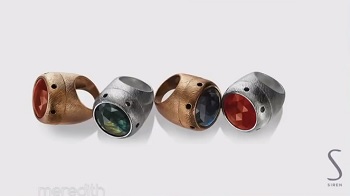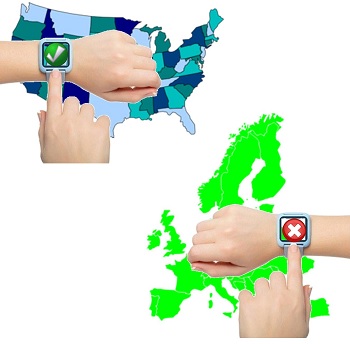A new type of wearables has been designed to assist consumers in protecting themselves against physical attack.
The risk of a physical attack is present in nearly any place and at any time, so a new type of wearable technology has now been developed in order to provide some practical benefit to the wearers and to provide useful advantages in that type of situation.
The new wearables were developed by Kat Alexander, who created the Siren Ring.
Alexander explained that “I was taking a shortcut and a man crossed my path and began to deliberately walk towards me.” Fortunately, she was able to escape the problem, but she did not leave the experience entirely behind herself. She created the Siren Ring, which is a piece of wearable technology that can be twisted in order to activate an alarm that sounds at 110 decibels.
This wearable technology is built to shock a potential attacker and to cause him or her to experience sensory overload.
 According to the owner of Command Excellence, John Sakoian, the shock from the noise of the ring could overload the senses of a potential attacker, which could be very handy in helping to make an escape. The company is provides local safety consulting services. He stated that it is a bright idea to use this wearable tech because it is easily accessible whenever the wearer requires it, even in an emergency.
According to the owner of Command Excellence, John Sakoian, the shock from the noise of the ring could overload the senses of a potential attacker, which could be very handy in helping to make an escape. The company is provides local safety consulting services. He stated that it is a bright idea to use this wearable tech because it is easily accessible whenever the wearer requires it, even in an emergency.
Though the ideal option is to call 911 in the case of an emergency, using a cell phone to reach the police, in the event that an individual is in true danger, taking out a smartphone and making a phone call may not be entirely possible.
The Siren Ring has a special alert button that can be activated through a smartphone app, as well. This mobile app opens up a number of additional features that can be accessed with the thumb. It offers various help features and panic buttons. There is a special wearable technology pod that can be placed on the body that can provide automatic injury detection in the event that a violent crime should occur.
A new report issued by Forrester Research has indicated that there will be a tripling of wearables users in 2015.
According to Forrester Research in a new report that they have recently released, the number of people who will be using wearable technology is going to triple throughout next year, when compared to this year’s figures.
This will, said the report, be greatly driven by the upcoming release of the Apple Watch, early next year.
The research firm has predicted that the Apple Watch, alone, will draw an additional 10 million users to the wearable technology category. This represents a more rapid growth rate than has been issued by a number of other forecasts, which feel as though the first wave of chunky, unfashionable, and just plain ugly prototypes and early generations of devices will have put many consumers off the idea for some time. But this new research indicates that next year will be a breakout for this trend.
That said, the interest in wearable technology was found to be greatly different between the U.S. and Europe.
 Polling data that was used in this Forrester Research study involved the participation of thousands of consumers throughout Europe and the United States. Among Americans 45 percent said that they could imagine themselves using wearables. That said, among Europeans, only 32 percent said that they would want to wear those devices.
Polling data that was used in this Forrester Research study involved the participation of thousands of consumers throughout Europe and the United States. Among Americans 45 percent said that they could imagine themselves using wearables. That said, among Europeans, only 32 percent said that they would want to wear those devices.
That said, within the wearables category, there are areas that consumers can picture themselves using more than others. For example, health monitors and smartwatches were among the items that consumers said that they were more likely to wear than other devices such as smart glasses. People seemed more willing to wear something on their wrists, followed by those that clip onto clothing. Lastly was those that were to be worn on the ear or face.
Even in the United States, there was a difference from one region to the next among the various categories of wearable technology. That said, in every area there were people who were willing to try everything from the aforementioned devices to smart jewelry, but even tech enhanced contact lenses and tattoos had some willing adopters.
 According to the owner of Command Excellence, John Sakoian, the shock from the noise of the ring could overload the senses of a potential attacker, which could be very handy in helping to make an escape. The company is provides local safety consulting services. He stated that it is a bright idea to use this wearable tech because it is easily accessible whenever the wearer requires it, even in an emergency.
According to the owner of Command Excellence, John Sakoian, the shock from the noise of the ring could overload the senses of a potential attacker, which could be very handy in helping to make an escape. The company is provides local safety consulting services. He stated that it is a bright idea to use this wearable tech because it is easily accessible whenever the wearer requires it, even in an emergency.
 Polling data that was used in this Forrester Research study involved the participation of thousands of consumers throughout Europe and the United States. Among Americans 45 percent said that they could imagine themselves using
Polling data that was used in this Forrester Research study involved the participation of thousands of consumers throughout Europe and the United States. Among Americans 45 percent said that they could imagine themselves using 